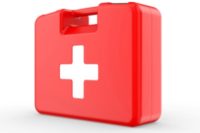ANSI/ISEA Z308 1-2015 for workplace first aid kits

Scope
ANSI/ISEA Z308 1-2015 classifies first aid kits based on the assortment and quantity of first aid supplies needed to deal with most types of injuries and sudden illnesses in the workplace. This includes major wounds, minor wounds (cuts and abrasions), minor burns, sprains and strains, and eye injuries.
Why this standard is important
OSHA's standard for first aid training in general industry (29 CFR 1910.151(b)) and construction (29 CFR 1926.50(c)) require that an employer must ensure prompt first aid treatment for injured employees.
Types of first aid kit containers
Type I intended for use in stationary, indoor settings where the potential for damage of kit supplies due to environmental factors and rough handling is minimal.
Type II intended for portable use in indoor settings where the potential for damage of kit supplies due to environmental factors and rough handling is minimal.
Type III intended for portable use in mobile, indoor and/or outdoor settings where the potential for damage of kit supplies due to environmental factors is not probable.
Type IV intended for portable use in the mobile industries and/or outdoor settings where the potential for damage to kit supplies due to environmental factors and rough handling is significant.
General requirements
First aid supplies (refer to standard for Class A Kits and Class B kits minimum quantities)
Adhesive Bandage Each adhesive bandage shall consist of a non-adherent absorbent pad attached to the central area of a strip of adhesive material 3.0 in. ± 1/16 in. (76 mm ± 1.6 mm) by 1.0 in. ± 1/32 in. (25.4 mm ± 0.8 cm).
Adhesive Tape Adhesive tape shall be at least 3/8 in. (9.5 mm) wide and a minimum of 2.5 yd (2.3 m) long and meet requirements for adhesive tape as defined in the USP/NF (United States Pharmacopeia and The National Formulary).
Antibiotic Application Each antibiotic application shall meet the applicable requirements in the current edition of the USP/NF.
Antiseptic Each antiseptic shall meet the requirements of all applicable FDA requirements and shall be contained in an individual-use, non-reusable application containing at least 1/57 oz. (0.5 g) of antiseptic.
Breathing Barrier The breathing barrier shall be a single use disposable medical device listed with the U.S. Food and Drug Administration (FDA) and have a current valid 510 (k) with the purpose of delivering ventilations by a responder to a non-breathing victim (e.g., rescue breaths and CPR ventilations).
Burn Dressing (gel soaked) Burn dressings shall be a sterile gel-soaked pad made of a material that prevents fibers from becoming imbedded in the burn wound. Gel material shall be water-soluable.
Burn Treatment Each burn treatment shall be a water soluble compound packaged in individual-use applications containing at least 1/32 oz. (0.9 g).
Cold Pack Each cold pack shall be at least 4 x 5 in. (10 x 12.5 cm) in size and shall reach a temperature between 20 - 40˚F (-6 - 4˚C) within 10 seconds of activation and shall maintain this temperature for a period of at least 10 minutes.
Eye Covering with means of attachment Eye covering(s) shall have the ability to cover both eyes, an area of at least 2.9 sq. in. (19 sq. cm) per eye, and conform to each eye cavity.
Eye/Skin A sterile, isotonic, buffered solution as specified in FDA regulation 21 CFR 349 shall be contained in at least 0.5 fl. oz. (15 ml) individual-use applications.
First Aid Guide Guidance for immediate care given to a victim of injury or sudden illness until arrival of more advance care, if needed, shall be included in the kits.
Hand Sanitizer Hand sanitizers shall be water-soluable with a minimum 62% ethyl alcohol as the active ingredient.
Medical Exam Gloves Gloves shall meet the requirements of FDA regulation 21 CFR 800.20 for medical grade gloves.
Roller Bandage (2 inch, 4 inch) Each bandage shall be constructed from a material at least the equivalent strength of Type I USP 28-NF23 (44/36) gauze as defined by the current edition of USP/NF. Each bandage shall be individually packaged and sealed.
Scissors Scissors shall be autoclavable, at least 3.5 in. long (8.9 cm), capable of cutting through clothing, feature a blunt end to protect a person from accidental injury and of medical professional quality.
Splint Each splint shall be padded, made of malleable material and shall be at least 4.0 in. x 24 in. (10.2 cm x 61.0 cm).
Sterile Pad Each sterile pad shall be at least 3 x 3 in. (7.5 x 7.5 cm) in size and shall have at least the absorbency of absorbent gauze as defined by the current edition of the USP/NF.
Tourniquet Each tourniquet shall be at least 1 in. (2.5 cm) wide.
Trauma Pad Each trauma pad shall be at least 45 sq. in. (290.33 sq cm) with no side smaller than 5 in. (12.7 sq cm) and shall have at least the absorbency of absorbent gauze as defined by the current edition of the USP/NF.
Triangular Bandage Each bandage shall be made from muslin at least 60/48 weave or a material of equivalent mechanical strength.
Sponsor: www.FirstAidOnly.com 800-886-6659
Looking for a reprint of this article?
From high-res PDFs to custom plaques, order your copy today!





